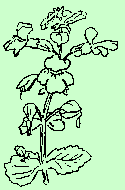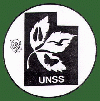|







|
. |
Mountain Flowers
by Dot K. Platt

|

 It is the time to follow spring up our mountains. In late April to mid-May
the dogtooth violet blooms along the lower canyons and foothills. Not a
violet at all, but a lily (Erythronium grandiflorum), it has
many names ... spring lily, snow lily, glacier lily, trout lily, avalanche
lily, fawn lily, mountain lily, Easter bells, adder's tongue, Chanaman's
hat, and probably other local names. In late July, it may be found at
10,000 feet in the high Uintas, when it is still spring there.
It is the time to follow spring up our mountains. In late April to mid-May
the dogtooth violet blooms along the lower canyons and foothills. Not a
violet at all, but a lily (Erythronium grandiflorum), it has
many names ... spring lily, snow lily, glacier lily, trout lily, avalanche
lily, fawn lily, mountain lily, Easter bells, adder's tongue, Chanaman's
hat, and probably other local names. In late July, it may be found at
10,000 feet in the high Uintas, when it is still spring there.
|
|
The yellow monkey flower (Mimulus guttatus) grows along
streams, and in a very few places you may find the beautiful Lewis
monkeyflower (Mimulus lewisii), a lovely deep rose color.
|

|

 The vivid blue Wasatch penstemon (Penstemon cyananthus) is
one of the loveliest of penstemons. The scarlet gilia (Gilia
aggregata) gives a dash of red to add to the beauty of the mountain
gardens. Several species of Indian paintbrush (Castilleja spp.)
grow in many different habitats, ranging from scarlet to deep rose pink to
white.
The vivid blue Wasatch penstemon (Penstemon cyananthus) is
one of the loveliest of penstemons. The scarlet gilia (Gilia
aggregata) gives a dash of red to add to the beauty of the mountain
gardens. Several species of Indian paintbrush (Castilleja spp.)
grow in many different habitats, ranging from scarlet to deep rose pink to
white.

 In Utah, the calypso orchid (Calypso bulbosa) is found only
rarely, in the Uintas, under pines. But some years ago, Dixie Rose and I
were told by a man that in British Columbia you could dig them up by the
shovelful. (Dixie was a UNSS member who wrote often about our flowers.)
Both she and I were very skeptical of his remarks. However, on my way to
Alaska, we camped at Jasper Park in Canada. As we put up camp, I could see
a drift of pink under the pines. I sent my daughter Shawn to see what it
was. She came back with a handful of Calypsos. I was astonished, and took
a whole roll of film to show Dixie. Unfortunately, Kodak lost my film !!
In Utah, the calypso orchid (Calypso bulbosa) is found only
rarely, in the Uintas, under pines. But some years ago, Dixie Rose and I
were told by a man that in British Columbia you could dig them up by the
shovelful. (Dixie was a UNSS member who wrote often about our flowers.)
Both she and I were very skeptical of his remarks. However, on my way to
Alaska, we camped at Jasper Park in Canada. As we put up camp, I could see
a drift of pink under the pines. I sent my daughter Shawn to see what it
was. She came back with a handful of Calypsos. I was astonished, and took
a whole roll of film to show Dixie. Unfortunately, Kodak lost my film !!
|
|

